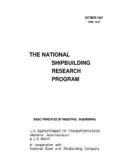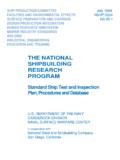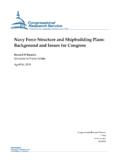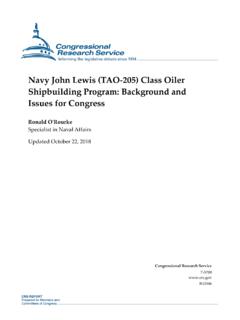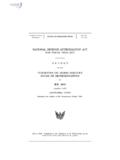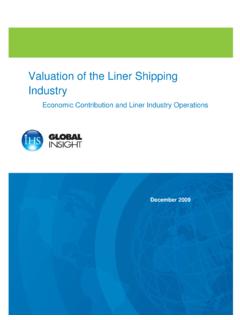Transcription of PEER REVIEW OF THE GERMAN SHIPBUILDING …
1 PEER REVIEW OF THE GERMAN SHIPBUILDING INDUSTRYPEER REVIEW OF THE GERMAN SHIPBUILDING industry 2 FOREWORD This report was prepared under the Council Working Party on SHIPBUILDING (WP6) peer REVIEW process. Delegates discussed a draft at the WP6 meeting on 10 November 2015. No substantive comments were received and delegates agreed to declassify the report. The report will be made available on the WP6 website: OECD 2016 Cover photo: MEYER WERFT/M. Wessels. Applications for permission to reproduce or translate all or part of this material should be made to: OECD Publications, 2 rue Andr -Pascal, 75775 Paris, Cedex 16, France; e-mail: This document and any map included herein are without prejudice to the status of or sovereignty over any territory, to the delimitation of international frontiers and boundaries and to the name of any territory, city or area.
2 PEER REVIEW OF THE GERMAN SHIPBUILDING industry 3 TABLE OF CONTENTS SUMMARY AND KEY POINTS .. 4 industry features .. 4 Structural change .. 4 Markets .. 4 Government support .. 5 PEER REVIEW OF THE GERMAN SHIPBUILDING AND MARINE SUPPLY industry .. 8 Background .. 8 I. GLOBAL PERSPECTIVE .. 9 Market and industry trends .. 9 II. STRUCTURE AND FEATURES OF THE GERMAN SHIPBUILDING AND MARINE SUPPLY industry .. 13 Overview .. 13 SHIPBUILDING .. 13 Marine supply industry .. 31 Emerging challenges and opportunities .. 32 III. GOVERNMENT POLICIES AFFECTING THE SHIPBUILDING industry .. 35 Policies at Federal and L nder levels .. 35 Support Measures .. 36 Trade promotion .. 43 IV. OUTLOOK .. 44 NOTES .. 45 REFERENCES.
3 47 ANNEX I: industry ASSOCIATIONS .. 54 Verband f r Schiffbau und Meerestechnik (VSM) .. 54 Verband Deutscher Maschinen und Anlagenbau (VDMA) Section Marine Equipment and Systems .. 55 ANNEX II: GERMAN SHIPBUILDING AND REPAIR COMPANIES .. 56 PEER REVIEW OF THE GERMAN SHIPBUILDING industry 4 SUMMARY AND KEY POINTS In 2012, the OECD s Council Working Party on SHIPBUILDING (WP6) introduced a peer REVIEW process, focused on support measures provided by governments to their SHIPBUILDING sectors. Under this process, each economy participating in the WP6 will undergo an in-depth study of their SHIPBUILDING industry and related government measures. Germany was the fourth country to be subject to a WP6 peer REVIEW , following the reviews of Japan (2012), Portugal (2013) and Korea (2014).
4 This report1 has been prepared to support the REVIEW , which took place at the 10 November 2015 WP6 meeting. Following are key points: industry features The GERMAN SHIPBUILDING industry is a relatively small component of the GERMAN economy as a whole. It is an important economic activity in the Baltic and North Sea area, where shipyards are concentrated. Most of Germany s ship yards are relatively small and family-owned, compared to state-owned yards or yards that are part of big shipyard groups in other countries. While Germany is the sixth largest SHIPBUILDING industry in the world (after China, Korea, Japan, the Philippines and Chinese Taipei), Germany s share is rather low, accounting for less than 1% of global ship completions in The supply industry has about three to four times more employees than the ship yards and is located throughout Germany.
5 Structural change The GERMAN SHIPBUILDING industry has undergone significant changes during the past 25 years. Following reunification in 1990, special government-led programmes were set up to help restructure, modernise and privatise the yards in East Germany. Throughout the period increased competition from, in particular, China, Japan and Korea resulted in a withdrawal from key markets for large container ships and tankers. The global financial crisis in 2007/2008 put further pressure on the industry , resulting in a series of bankruptcies and consolidation. Many of the bankrupt yards were acquired by other yards or investors, leading to the creation of 8 major shipyard groups which together control 24 yards, out of the total of more than 40 yards for ocean-going ships.
6 In contrast, the marine supply industry has not undergone changes of this extent and has maintained its position as a leading supplier of the components and equipment used in SHIPBUILDING to world markets. Within Germany, the supply industry provides shipbuilders with equipment that represents about 70% of the value of final production. Markets The SHIPBUILDING industry has become more specialised, focusing on products which are custom built and require excellent system integration skills. With respect to ocean-going vessels, the industry is a world leader in the construction of large cruise ships, the market for which is small, but highly demanding. The leading position that Germany has taken in this market is one which PEER REVIEW OF THE GERMAN SHIPBUILDING industry 5has evolved over a lengthy period of time.
7 At present only three other yards, two of which are European, compete in this market. In addition to cruise ships, which are only produced by two companies (Meyer Werft and Lloyd Werft), GERMAN yards are also focusing attention on other customised products, such as research vessels, ferries, patrol boats, mega-yachts and vessels as well as platforms serving the needs of the offshore oil and gas and offshore wind farm industries. The market for inland vessels, such as barges, cruise vessels and ferries, has also been maintained as it tends to be more localised in nature. Government support Governments, at European, national and regional levels have played an important supportive role for the SHIPBUILDING industry .
8 In the case of the GERMAN SHIPBUILDING industry , the federal government has focused on providing the industry with the financial support needed to compete with foreign shipbuilders, through the guarantee of the loans taken out by foreign parties to purchase ships, and through the support of international agreements that discourage interest rate subsidisation. Furthermore, there are government programmes to maintain the industry s edge in research, development and innovation (RDI). The GERMAN government has also played a significant role in guiding and supporting restructuring in the industry . The most successful efforts have been in instances where assistance was provided to encourage the development of new economic activities in regions that faced economic pressure as a result of intense foreign competition.
9 Following is a summary of the types of support provided to the industry in recent years: European level. At European level, special programmes have been maintained for many years to improve the competitive position of the industry . In this regard, the EU has set out the frameworks for R&D support in its member states. On that basis, Germany has pursued possibilities to provide special financial aid for research and development and innovation (RDI), and to provide financial support for exports. The sectoral RDI schemes, however, expired in 2014, so there are no special provisions for SHIPBUILDING in these areas. Instead, RDI aid for the SHIPBUILDING sector is now based on the horizontal (cross-sectoral) RDI provisions.
10 In addition, the European Commission oversees a multi-stakeholder exercise which has developed a vision for the industry for the year 2020, together with a series of recommendations to help realise the industry s RDI projects. Germany. In Germany, the SHIPBUILDING industry has been a sector of strategic importance for decades. In recent years Federal government, L nder and local governments have widened the political focus to include the maritime industry as a whole, which includes maritime equipment makers and offshore industries, such as the oil, gas and wind energy industries. Institutional support Since 2000, the federal government has convened a national maritime conference that brings together experts from industry , academia, research organisations, trade unions and government to discuss issues and develop proposals for increasing the competitiveness of the GERMAN maritime industry .










